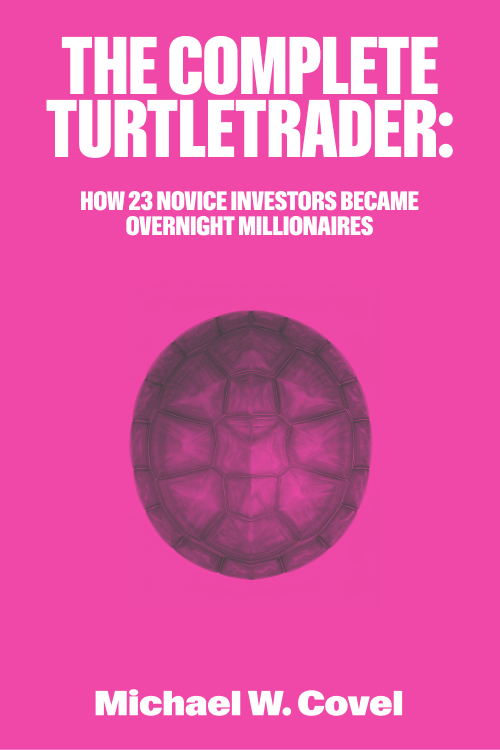In a financial world often led by ego, gut feelings, and secret knowledge, The Complete Turtle Trader goes against tradition entirely. At the heart of the story stands Richard Dennis, famously known as the “Prince of the Pit,” who strongly believed that trading skill is not born. His simple yet radical idea, detailed in The Complete TurtleTrader, was to gather a group with no formal background, elite degrees, or market experience, and train them to succeed using strict rules, not their own feelings.
What followed was a direct challenge to Wall Street’s oldest beliefs. Using philosophy, probability, and behavioral science, Dennis and William Eckhardt developed a system that stripped the mystery from trading, replacing gut feeling with facts and randomness with strict structure, a core concept of The Complete Turtle Trader.
This book, The Complete TurtleTrader, is more than just the story of a successful experiment; it declares the value of rational, systematic thinking in an industry too often ruled by noise and emotion. From a simple classroom in Chicago to the complex world of international futures markets, The Complete Turtle Trader traces a journey of mental and financial change. It explains how discipline can be taught, how reason can conquer fear, and how determined people used trend-following principles to achieve great success, as documented in The Complete TurtleTrader.
They proved that greatness can be built, not just inherited.
Chapter 1: Nurture versus Nature: The Core Wager of The Complete TurtleTrader
In the 1980s, Chicago trader Richard Dennis—the “Prince of the Pit”—held a strong belief: market success comes from following a method, not from natural talent. To prove this, he made a provocative wager with William Eckhardt. He was confident he could train ordinary novices to become expert traders, a promise central to The Complete TurtleTrader. Their goal, as documented in The Complete TurtleTrader, was to replicate Dennis’s success using precise rules, empirical data, and controlled capital management.
They launched a search through quiet financial ads, purposely avoiding Ivy League elites or Wall Street insiders. Instead, they sought adaptable minds committed to rules, probability, and calm capital management for The Complete TurtleTrader program. Out of over a thousand applicants—musicians, servers, game designers, and historians—they selected a unique group.
This effort was an early social experiment, testing a timeless question: Are traders born or made? Dennis bet on the latter, seeing markets as contests of probability, not emotional battles. This chapter sets the stage for the challenge to market myths detailed in The Complete TurtleTrader.
Chapter 2: Prince of the Pit and the Genesis of The Complete TurtleTrader
Richard Dennis was no mere academic; he turned his humble South Chicago beginnings into a huge fortune before age thirty. On the chaotic trading pits, his calm, methodical approach stood out. While others chased rumors, Dennis analyzed price patterns with mathematical precision, guided by probability and risk, the same principles later used in The Complete TurtleTrader.
Dennis’s early days were a training ground where he perfected his craft. Based on real-world evidence, he dismissed guesswork and focused only on measurable results. His success earned respect from seasoned traders. Yet, Dennis viewed his growing capital as a sign of performance, not a personal trophy, a perspective essential to The Complete TurtleTrader.
This chapter reveals Dennis as a philosopher, gambler, and genius who knew that mastering volatile markets required a completely different approach—the one that defined The Complete TurtleTrader system.
Chapter 3: The Turtles: The Experimental Novices of The Complete TurtleTrader
The selection of the “Turtles” was bold and unusual. The chosen individuals—a mix of backgrounds, forming an experimental group—defied all common stereotypes. Despite their differences, they shared one key trait: disciplined minds ready to follow strict rules without question. Richard Dennis trained them and gave them capital, closely watching their progress, as Michael W. Covel recounts in The Complete TurtleTrader.
The training was intense, focusing on building a mindset similar to a rational machine. Emotions and instincts were forbidden. The rule was absolute: follow the system and the risk protocols outlined in The Complete TurtleTrader.
Thus, a legend was born. With just two weeks of instruction and a brief rulebook, these novices were given millions to trade. Some failed due to emotional mistakes; others succeeded. Beyond the individual stories, the experiment showed that disciplined, rational adherence—not elite talent—drives speculative success in The Complete TurtleTrader.
Chapter 4: The Philosophy of The Complete TurtleTrader: Rules Over Emotion
At the core of Dennis and Eckhardt’s teaching was more than just technical rules—it was a new way of thinking. Their goal was to reshape the traders’ minds, removing emotion from decisions, which is the heart of The Complete TurtleTrader’s philosophy. As Michael W. Covel explains, success depends on sticking to a rigorous process rather than relying on chance intuition.
They taught that price alone was the truth, dismissing news, rumors, and expert opinions as distractions. Their strategy was trend following: they waited for a clear market direction and then followed the momentum. This approach is fundamental to The Complete TurtleTrader‘s design.
Dennis and Eckhardt stressed discipline, logic, and humility, reminding traders that mastering oneself was the only absolute control in chaotic markets, a central tenet of The Complete TurtleTrader.
Chapter 5: The Rules: Building the Foundation of The Complete TurtleTrader
Building on their philosophy, Dennis and Eckhardt introduced clear, strict, and mathematically sound rules. These rules completely removed emotion from trading decisions, the main practical goal of The Complete TurtleTrader.
The Turtles learned two main systems. Both systems used historical highs and lows to signal trades and applied volatility-based stops to limit losses or secure profits. Their goal was not to guess the exact tops or bottoms but to ride trends until a clear reversal signal appeared, as taught in The Complete TurtleTrader.
Risk management was the absolute foundation of The Complete TurtleTrader‘s method. Each trade risked only a small fixed percentage of capital. A consistent presence in the market, guided by the rules of The Complete TurtleTrader, led to lasting success.
Chapter 6: In the Womb: The Intensive Training for The Complete TurtleTrader
Before trading any real money, the Turtles were created in a strict learning environment, shielded from Wall Street distractions. Their classroom was simple, but the focus was intense, as Michael W. Covel describes the beginning of The Complete TurtleTrader program.
Dennis and Eckhardt introduced “N,” a custom volatility measure used to calculate risk, entry points, and stops, ensuring every decision was computed with mathematical precision. The trainees rehearsed trade scenarios and drilled stop-loss discipline with military rigor.
Within this disciplined framework, a major change occurred. These novices gained confidence and embraced the process, developing a strong sense of self-belief. What started as a theory became a living reality. Within this intellectual womb, the students of The Complete TurtleTrader prepared for the harsh realities of live trading.
Chapter 7: Deploying Capital: The Real-World Test for The Complete TurtleTrader
After training, the Turtles faced the true reality: managing real capital. Richard Dennis entrusted each with millions of dollars to trade. Every Turtle followed the same strict rules from The Complete TurtleTrader, regardless of account size.
This tested both discipline and their ability to adjust. Execution needed precision tailored to each market’s character, even while adhering to the structure of The Complete TurtleTrader.
This was Dennis’s actual test for the pupils of The Complete TurtleTrader: seeing who would stick to the rules under stress and who would break them.
Chapter 8: Game Over: Failure and Discipline in The Complete TurtleTrader
Not all Turtles succeeded under the pressure. Despite solid rules and intense training, some failed under real-world stress and left the experiment too soon. Michael W. Covel highlights that the market quickly punished such errors in the context of The Complete TurtleTrader.
Dennis, despite his success, felt disappointed. His vision—to build perfectly rational traders—collided with the stubborn realities of human emotion.
Ultimately, Dennis proved his central point from The Complete TurtleTrader: disciplined trading can be taught, but unwavering commitment isn’t guaranteed. Success depends more on behavior than intelligence, a key lesson of The Complete TurtleTrader.
Chapter 9: Out on Their Own: The Turtles After The Complete TurtleTrader Program
After the formal training ended, the Turtles entered the market independently. Some strictly followed Dennis’s original methods. Others moved into new areas, launching funds or adapting their systems. Though their paths diverged, all shared a foundation from The Complete TurtleTrader.
The legacy of The Complete TurtleTrader lives on. The Turtle Experiment became a symbol of learnable trading skills, challenging old myths about innate talent. The Turtles had been released, and some continued riding market waves with steady conviction thanks to the lessons of The Complete TurtleTrader.
Chapter 10: Dennis Returns: Testing The Complete TurtleTrader Anew
Richard Dennis never saw his exit from trading as a defeat. He returned not just to prove a point, but to re-engage with his passion. Michael W. Covel narrates this renewed chapter in the story of The Complete TurtleTrader.
He launched a new fund based on the same core principles of The Complete TurtleTrader. This time, there was no buffer—just raw market volatility and his unwavering discipline.
Dennis faced skepticism. Critics wondered if his old philosophy could still work in an age of algorithms. Yet Dennis stayed firm. For him, trading symbolized more than profit—it reflected the discipline and purpose of The Complete TurtleTrader.
Chapter 11: Seizing Opportunity: Decisiveness, a Key Lesson from The Complete TurtleTrader
Opportunities rarely appear clearly. The Turtles learned that hesitation could mean financial disaster, a lesson emphasized throughout The Complete TurtleTrader.
Their most vital lesson, drawn from The Complete TurtleTrader, went beyond charts: decisiveness matters. Acting quickly when the window opened, both in markets and in life, was crucial.
This chapter shows that trend following extends beyond finance, shaping how Turtles approached careers and innovation after The Complete TurtleTrader program.
Chapter 12: Failure Is a Choice
Michael W. Covel challenges the idea of chance by revealing that most trading failures come from self-sabotage. People fail not because the odds are unfair but because they ignore the principles needed to navigate markets effectively, the very principles taught in The Complete Turtle Trader.
Among the Turtles, failure took many forms. Some broke under pressure; others tried to be smarter than the system that brought them success.
Dennis made his message clear in The Complete TurtleTrader: those who follow the rules will eventually succeed. Success depends more on behavior than intelligence or information, a key takeaway from The Complete TurtleTrader.
Chapter 13: Second-Generation Turtles
The influence of the original methods spread far beyond Dennis’s classroom. Michael W. Covel traces this legacy through a second generation. This new wave discovered the principles of The Complete TurtleTrader independently.
The core philosophy remained flexible—a craft refined, much like martial arts, passed from teacher to student.
The answer lay in resilience, not simple imitation. Those who succeeded embraced the essence—cutting losses quickly, letting winners run, and distinguishing signal from noise through innovative adaptation. This shows the enduring power of the methodology described in The Complete Turtle Trader.
Chapter 14: Model Greatness
In his final reflection, Michael W. Covel goes beyond a simple conclusion; he provokes thought. True greatness is not about innate brilliance or charisma but about building reliable models that last, as in the system described in The Complete Turtle Trader.
The Complete Turtle Trader proved this: Dennis relied not on instinct but on logical, probabilistic rules tested in fundamental markets with ordinary people. The result was clear—success can be copied.
Covel’s final principle is clear: sustainable success demands structure, scientific thinking, and strategic action. The story of The Complete Turtle Trader shows that the Turtles were not lucky anomalies; they were designed.
Final Words
What remains at the conclusion of The Complete Turtle Trader is more than a transformation—it is a profound idea: success is deliberately engineered, not accidental.
Richard Dennis rejected intuition, charisma, and chance, instead creating a system based on discipline, probability, and repeatable logic, the foundation of The Complete Turtle Trader.
The Turtles proved that forecasting markets is unnecessary; the true skill lies in consistently and calmly responding to market movements. Michael W. Covel reaffirms a central principle: discipline outweighs prediction.
Each deliberate entry, calculated loss, and sustained position conveys a clear message—success demands preparation and commitment to the proven method of The Complete Turtle Trader.
If you’re interested in exploring similar concepts related to probability, risk, and decision-making, you might also enjoy summaries of Taleb’s other works, like Algo Trading Cheat Codes or Antifragile, available here.


